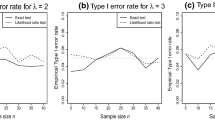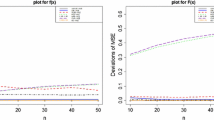Abstract
In many practical situations, it is effective to use statistical methods based on Gaussian distributions, and, more generally, distribution for which tails are light – in the sense that as the value increases, the corresponding probability density tends to 0 very fast. There are many theoretical explanations for this effectiveness. On the other hand, in many other cases, it is effective to use statistical methods based on heavy-tailed distributions, in which the probability density is asymptotically described, e.g., by a power law. In contrast to the light-tailed distributions, there is no convincing theoretical explanation for the effectiveness of the heavy-tail-based statistical methods. In this paper, we provide such a theoretical explanation. This explanation is based on the fact that in many applications, we approximate a continuous distribution by a discrete one. From this viewpoint, it is desirable, among all possible distributions which are consistent with our knowledge, to select a distribution for which such an approximation is the most accurate. It turns out that under reasonable conditions, this requirement (of allowing the most accurate discrete approximation) indeed leads to the statistical methods based on the power-law heavy-tailed distributions.
Access this chapter
Tax calculation will be finalised at checkout
Purchases are for personal use only
Similar content being viewed by others
References
Aczél, J.: Lectures on Functional Equations and Their Applications. Dover, New York (2006)
Barabasi, A.-L.: Network Science. Cambridge University Press, Cambridge (2016)
Beirlant, J., Goegevuer, Y., Teugels, J., Segers, J.: Statistics of Extremes: Theory and Applications. Wiley, Chichester (2004)
Chakrabarti, B.K., Chakraborti, A., Chatterjee, A.: Econophysics and Sociophysics: Trends and Perspectives. Wiley-VCH, Berlin (2006)
Chatterjee, A., Yarlagadda, S., Chakrabarti, B.K.: Econophysics of Wealth Distributions. Springer-Verlag Italia, Milan (2005)
Farmer, J.D., Lux, T. (eds.) Applications of statistical physics in economics and finance, a special issue of the Journal of Economic Dynamics and Control, vol. 32(1), pp. 1–320 (2008)
Fishburn, P.C.: Utility Theory for Decision Making. Wiley, New York (1969)
Gomez, C.P., Shmoys, D.B.: Approximations and randomization to boost CSP techniques. Ann. Oper. Res. 130, 117–141 (2004)
Jaynes, E.T., Bretthorst, G.L.: Probability Theory: The Logic of Science. Cambridge University Press, Cambridge (2003)
Kreinovich, V., Kosheleva, O., Nguyen, H.T., Sriboonchitta, S.: Why some families of probability distributions are practically efficient: a symmetry-based explanation. In: Huynh, V.N., Kreinovich, V., Sriboonchitta, S. (eds.) Causal Inference in Econometrics, pp. 133–152. Springer Verlag, Cham (2016)
Luce, R.D., Raiffa, R.: Games and Decisions: Introduction and Critical Survey. Dover, New York (1989)
Malkiel, B.G.: A Random Walk Down Wall Street: The Time-Tested Strategy for Successful Investing. W. W. Norton & Company, New York (2007)
Mandelbrot, B.: The variation of certain speculative prices. J. Bus. 36, 394–419 (1963)
Mandelbrot, B.: The Fractal Geometry of Nature. Freeman, San Francisco (1983)
Mandelbrot, B., Hudson, R.L.: The (Mis)behavior of Markets: A Fractal View of Financial Turbulence. Basic Books, New York (2006)
Markovich, N. (ed.): Nonparametric Analysis of Univariate Heavy-Tailed Data: Research and Practice. Wiley, Chichester (2007)
McCauley, J.: Dynamics of Markets, Econophysics and Finance. Cambridge University Press, Cambridge (2004)
Nguyen, H.T., Kosheleva, O., Kreinovich, V.: Decision making beyond Arrow’s ‘impossibility theorem’, with the analysis of effects of collusion and mutual attraction. Int. J. Intell. Syst. 24(1), 27–47 (2009)
Novitskii, P.V., Zograph, I.A.: Estimating the Measurement Errors. Energoatomizdat, Leningrad (1991). (in Russian)
Orlov, A.I.: How often are the observations normal? Ind. Lab. 57(7), 770–772 (1991)
Rabinovich, S.G.: Measurement Errors and Uncertainty: Theory and Practice. Springer Verlag, Berlin (2005)
Raiffa, H.: Decision Analysis. Addison-Wesley, Reading (1970)
Resnick, S.I.: Heavy-Tail Phenomena: Probabilistic and Statistical Modeling. Springer-Varlag, New York (2007)
Sheskin, D.J.: Handbook of Parametric and Nonparametric Statistical Procedures. Chapman and Hall/CRC, Boca Raton, Florida (2011)
Stoyanov, S.V., Racheva-Iotova, B., Rachev, S.T., Fabozzi, F.J.: Stochastic models for risk estimation in volatile markets: a survey. Ann. Oper. Res. 176, 293–309 (2010)
Vasiliki, P., Stanley, H.E.: Stock return distributions: tests of scaling and universality from three distinct stock markets. Phy. Rev. E Stat. Nonlinear Soft Matter Phy. 77(3), Pt. 2, Publ. 037101 (2008)
Acknowledgments
We acknowledge the partial support of the Center of Excellence in Econometrics, Faculty of Economics, Chiang Mai University, Thailand. This work was also supported in part by the National Science Foundation grants HRD-0734825 and HRD-1242122 (Cyber-ShARE Center of Excellence) and DUE-0926721, and by an award “UTEP and Prudential Actuarial Science Academy and Pipeline Initiative” from Prudential Foundation.
The authors are thankful to the anonymous referees for valuable suggestions.
Author information
Authors and Affiliations
Corresponding author
Editor information
Editors and Affiliations
Rights and permissions
Copyright information
© 2016 Springer International Publishing AG
About this paper
Cite this paper
Sriboonchitta, S., Kreinovich, V., Kosheleva, O., Nguyen, H.T. (2016). Need for Most Accurate Discrete Approximations Explains Effectiveness of Statistical Methods Based on Heavy-Tailed Distributions. In: Huynh, VN., Inuiguchi, M., Le, B., Le, B., Denoeux, T. (eds) Integrated Uncertainty in Knowledge Modelling and Decision Making. IUKM 2016. Lecture Notes in Computer Science(), vol 9978. Springer, Cham. https://doi.org/10.1007/978-3-319-49046-5_44
Download citation
DOI: https://doi.org/10.1007/978-3-319-49046-5_44
Published:
Publisher Name: Springer, Cham
Print ISBN: 978-3-319-49045-8
Online ISBN: 978-3-319-49046-5
eBook Packages: Computer ScienceComputer Science (R0)




